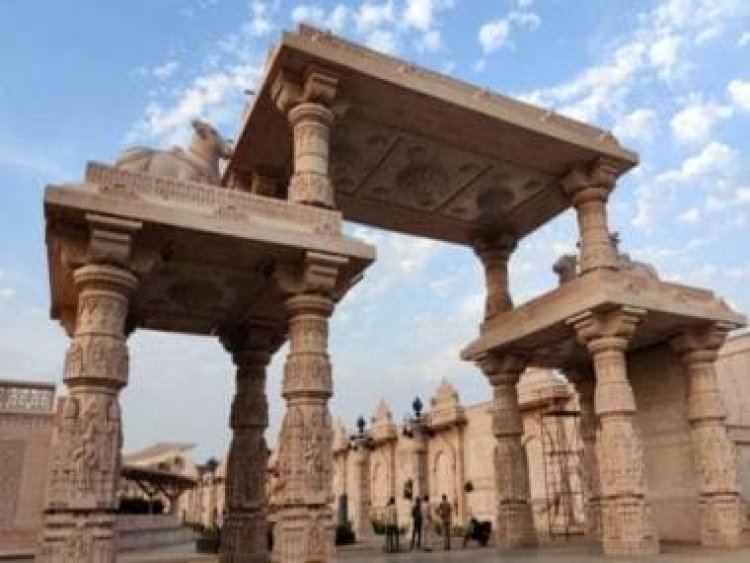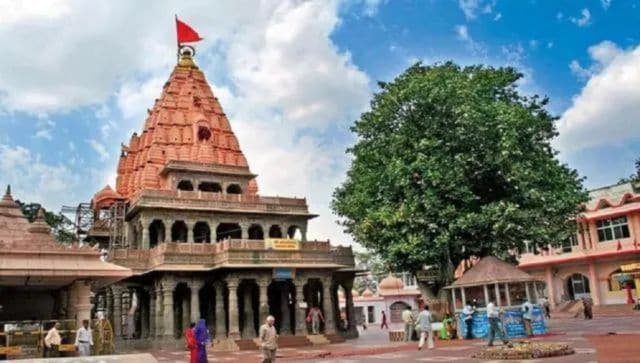The Mahakal Lok Corridor and the legends surrounding the Lord Shiva temple in Ujjain
The Mahakal Lok Corridor and the legends surrounding the Lord Shiva temple in Ujjain

Prime Minister Narendra Modi inaugurated the first phase of ‘Shri Mahakal Lok’ corridor in Ujjain, Madhya Pradesh today (11 October) by unveiling a large ‘shivling’ covered in sacred red threads.
Donned in traditional dhoti and gamcha (stole), Modi also performed a puja at Lord Mahakal temple ahead of the inauguration.
Madhya Pradesh chief minister Shivraj Singh Chouhan, state governor Mangubhai C Patel and Union minister Jyotiraditya Scindia were also present at the occasion.
People from all villages of Indore and Ujjain division, local people’s representatives, traditional village heads and priests were given special invitations to attend the event, PTI reported.
#WATCH | Ujjain, MP: PM dedicates to the nation Shri Mahakal Lok. Phase I of the project will help in enriching the experience of pilgrims visiting the temple by providing them with world-class modern amenities
Total cost of the entire project is around Rs 850 cr.
(Source: DD) pic.twitter.com/J1UnlU9XLa
— ANI (@ANI) October 11, 2022
After the inauguration, the PM addressed a gathering at the Kartik Mela Ground in Ujjain.
The inauguartion of the first phase of Rs 856-crore Mahakaleshwar Temple corridor development project comes a year before the 2023 Assembly polls in Madhya Pradesh.
The Chouhan government has vowed to complete the second and final phase of the project in 2023-24.
What are the features of the Mahakal Lok corridor and what is the significance of the Mahakaleshwar Temple for Hindus?
Let’s have a closer look.
ALSO READ: From Mahakal Lok Corridor to Kashi Vishwanath, how Narendra Modi is reviving temples across India
Mahakal Lok corridor
Built at a cost of Rs 351 crore, the ‘Shri Mahakal Lok’ corridor has 108 ornate sandstone pillars in a row with “decorative ‘trishul‘ design on top and ‘mudras’ of Lord Shiva on its faces”, reports PTI.
The 900-metre long corridor is four times the size of the Kashi Vishwanath corridor in Uttar Pradesh’s Varanasi, which the PM had inaugurated last year.
The Mahakal Lok corridor, flanked by Nandi Dwaar and the Pinaki Dwaar, is adorned with 93 statues that depict stories revolving around Lord Shiva, such as Shiv Vivah, Tripurasur Vadh, Shiv Puran, and Shiv Tandav Swaroop, as per Indian Express.
The first phase of the Mahakaleshwar Temple corridor development project also includes features like lotus pond, open-air theatre, and lakefront along with various facilities for the visitors.
Under the project, the Mahakal temple premises of around 2.82 hectares will be expanded to 47 hectares, reports Indian Express.
Mahakal temple’s significance
Ujjain’s famed Mahakaleshwar temple is one of the 12 ‘jyotirlingas’ in the country. The other jyotirlinga shrines include Somnath and Nageshwar in Gujarat, Viswanath in Uttar Pradesh, Kedarnath in Uttarakhand, Mallikarjuna in Andhra Pradesh, Omkareshwar in Madhya Pradesh, Bhimashankar, Triyambakeshwar and Grishneshwar in Maharashtra, Baidyanath in Jharkhand, and Rameshwar in Tamil Nadu.
अवन्तिकायां विहितावतारं, मुक्ति प्रदानाय च सज्जनानाम्।
अकालमृत्योः परिरक्षणार्थं, वन्दे महाकाल महासुरेशम्।।
जय महाकाल।। pic.twitter.com/LUoLKfYe1p
— Narendra Modi (@narendramodi) October 11, 2022
Devotees throng the Mahakal temple, one of the most sacred temples of Lord Shiva, during the entire year from across the country and the footfall increases, especially, during the Shravan month of the Hindu calendar.
The bhasma-aarti (offering ashes) is the first ritual performed in the temple to wake up the deity after Jal Abhishek at 4 am.

The aarti is done with vibhuti or sacred ash as Mahakaleshwar is revered as the God who controls time, reports Times Now.
There are several legends associated with the Mahakal temple, which is the only jyotirlinga facing south or dakshinamukhi.
All other jyotirlingas face east, as per Indian Express.
It is believed death’s direction is south and as Mahakal or Lord Shiva faces this side, he is considered the master of death, says Art of Living website.
The Mahakal lingam is believed to be Swayambhu (self-manifested), notes Times of India.
Moreover, believers worship Mahakaleshwar to keep untimely death at bay.
Mahakal’s myth
As per many reports, the Mahakal temple, located alongside the holy river Kshipra, has been reconstructed several times.
Hindu mythology attributes the construction of the Mahakal jyotirlinga of the temple to Lord Brahma.
विहंगम दृश्य!
सतत् साधना, पूरा मनोयोग, असीम धैर्य, अटल दृढ़संकल्प, अपरिमेय ऊर्जा और अपराजेय जज्बे के परिणामस्वरूप आज उज्जयिनी विलक्षण वैभव से सराबोर है।
इस अद्भुत #ShriMahakalLok को देखकर सनातन धर्म में हमारी आस्था और अधिक प्रबल होगी।
।। जय महाकाल ।। pic.twitter.com/3j9SvY5jgb
— Shivraj Singh Chouhan (@ChouhanShivraj) October 9, 2022
A local legend says there was once a king named Chandrasena in Ujjain who was an ardent Shiva devotee. When Chandrasena’s kingdom was attacked by his enemies with the help of a demon named Dushanan, Shiva appeared in the Mahakal form and destroyed them, as per Art of Living’s blog on ‘Mahakaleshwar Jyotirlinga: The only South-facing Linga’.
According to Outlook, the temple can be traced back to the sixth Century AD when it was built by Kumarasena, the son of a former king of Ujjain, Chandpradyot.
The temple was rebuilt in the 12th Century AD under the tenure of kings Udayaditya and Naravarman.
The temple complex was reportedly destroyed by Turk ruler Shams-ud-din Iltutmish in the 13th Century when he raided Ujjain.
The temple in its present form consisting of a five-storeyed structure was built by the Maratha general Ranoji Shinde in 1734.
The Scindias, the Maratha ruling family of Gwalior, revamped the marble walkways of the temple in the 19th century, as per Indian Express.
The different architectural patterns such as Maratha, Bhumija and Chalukya reflect the many renovations of the Mahakaleshwar temple in the past.
With inputs from agencies
Read all the Latest News, Trending News, Cricket News, Bollywood News,
India News and Entertainment News here. Follow us on Facebook, Twitter and Instagram.
What's Your Reaction?



























































